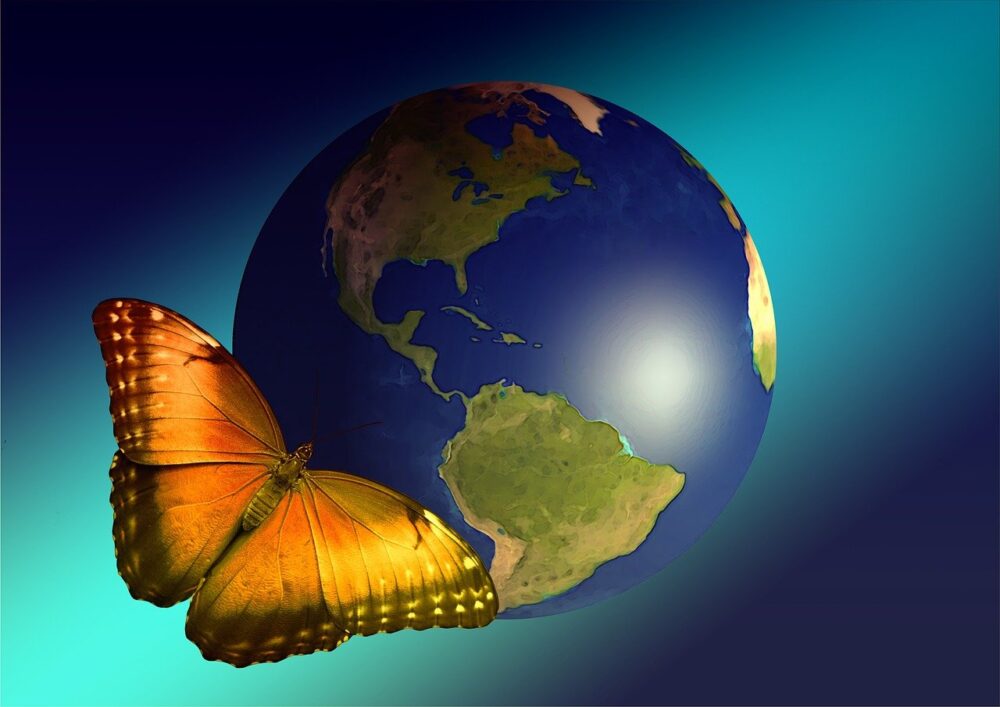In 1952, famous science fiction writer Ray Bradbury published a short story titled, “A Sound of Thunder.” Set in the year 2055, time travel has become a real (and profitable) technology, and a group of affluent hunters goes back in time on a guided safari to kill a Tyrannosaurus rex. Although the safari company has strict procedures to minimize any changes that could occur in the future because of their actions — staying on the levitating path, only killing “tagged” species that were supposed to die within a few minutes anyway, not leaving any artifacts in the past like bullets — one hunter loses his nerve and steps off the path. Upon returning to the present, they find reality irrevocably changed: The English language has been altered, and the fascist candidate who originally lost has now won the presidential election. Looking at the mud caked under his boots, the hunter finds a single crushed butterfly.
It wasn’t until 20 years after the story was published that the term “butterfly effect” was officially coined by meteorologist Edward Lorenz who discovered that
tiny, “butterfly-sized “changes made at the start of his computer weather models led to dramatically different and unpredictable results, from clear skies to devastating storms.
Nevertheless, Bradbury’s story is one of the most well-known examples of this amplifying tenet of chaos theory, and while time travel and hunting dinosaurs are still only works of science fiction, the idea that something as small as a butterfly can have a massive large-scale effect in the future is very much true for ecology and climate change.
Conservation efforts and climate change have been major points of contention in political and international spheres, especially in recent years. Since 1970, global carbon emissions have increased by over 90 percent, primarily because of fossil fuels and human activities that drive habitat loss and deforestation. About one-third of the world’s species are projected to go extinct in 50 years. In 2018, headlines broke out in a panic when the United Nations Intergovernmental Panel on Climate Change (IPCC), a body composed of climate researchers from over 40 countries, released their special report on the current climate situation. In this report, they analyzed over 30,000 scientific papers and presented options for policymakers to implement systemic changes to combat the Earth’s increasing temperatures. According to the IPCC, we had a little over a decade to mitigate climate change before we faced catastrophic and irreversible consequences. That was three years ago.
The causes of climate change and species endangerment are clear. But while the future is projected to be bleak, the true extent of their effects can be extremely difficult to predict like “A Sound of Thunder” illustrates. However, researchers from the University of Alberta have found an interesting way to better quantify the complex impact climate change has on ecosystems.
By using climate models that simulate the migration patterns of specific butterfly species in North America, the researchers were able to analyze the distribution of an alpine butterfly, Parnassius smintheus, in areas with and without their primary source of food, a plant called Sedum lanceolatum. They also compared these projections to those of four other species of alpine butterflies; however, these species fed on several different types of plants. The researchers had found that P. smintheus experienced significant habitat loss in dry-climate areas that were no longer able to grow S. lanceolatum compared to areas of normal climate. Their habitat range was also significantly smaller than those of the other butterfly species, highlighting how climate change can disproportionately affect species that rely on specific or limited food sources and can ultimately reduce biodiversity.
These findings have huge implications in modeling species distribution in response to climate change. They show the importance of tracking not only the direct effects, such as migration patterns and population numbers, but also the indirect effects, such as temperature and local food availability. This focus on trophic, or food-related, structure could be applied towards modeling ecosystems that are much larger and more complicated than just butterflies and plants, especially since the effects of climate change will likely spread to multiple species in a food web.
Based on the rate that human-driven climate change is severely influencing factors like the environment, weather, and biodiversity, Earth has a countdown timer. Until the world’s governments significantly crack down on carbon emissions and implement meaningful change in the ways we interact with ecosystems, manage waste, and generate energy, hopefully we can avoid stepping on any butterflies in the meantime.
Source: 1
Image Source: Pixabay






